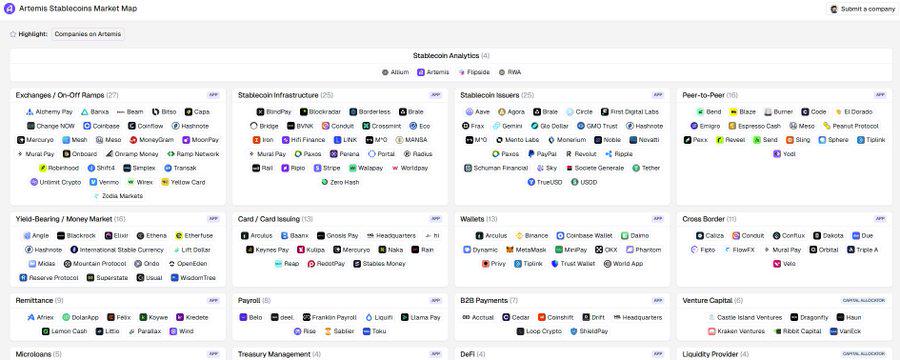
Original Author: Rob Hadick, General Partner at Dragonfly
Translation: Yuliya, PANews
As the stablecoin ecosystem continues to evolve, market attention towards its future development direction and value distribution is increasing day by day. This article will delve into various tracks of the stablecoin market and their value potential from multiple dimensions.
Compared to traditional frameworks, this analysis adopts a more detailed classification method, stemming from the complexity and subtle differences inherent in the payment field. For investors, accurately grasping the role positioning and ownership structure of each participant is particularly important. The main classifications include:
Settlement Rails
Stablecoin Issuers
Liquidity Providers
Value Transfer/Currency Services
Aggregated APIs/Messaging Platforms
Merchant Gateways
Stablecoin-Driven Applications
Some may ask: Why are there so many categories, especially when core infrastructures like wallets or third-party compliance are not covered? This is because each area has its unique defensive "moat" and different ways of capturing value. Although there is overlap among providers, understanding the uniqueness of each layer is crucial. Below is an analysis of the value distribution across various fields:
1. Settlement Rails
This is a typical area dominated by network effects, with core competitive advantages reflected in:
Deep liquidity
Low fee structure
Fast settlement
Stable system availability
Native compliance and privacy protection
This is likely to create a winner-takes-all market. General-purpose blockchains struggle to meet the scalability needs of mainstream payment networks, while Layer 2 or dedicated solutions may have greater development potential. The winners in this field will be highly valuable and are likely to focus on the stablecoin/payment sector.
2. Stablecoin Issuers
Currently, issuers like Circle and Tether have achieved significant success due to strong network effects and a high-interest rate environment. However, future development requires:
Building efficient and reliable infrastructure
Enhancing compliance standards
Optimizing minting/redemption processes
Strengthening integration with central banks and core banking systems
Improving overall liquidity (e.g., Agora)
While SaaS models like Paxos (Stablecoin as a Service) may spawn more competitors, stablecoins issued by neutral non-bank institutions and fintechs may have an advantage, as transactions between closed systems require a trusted neutral third party. Issuers already hold substantial value, and some will continue to win big, but they need to develop more comprehensive businesses beyond just issuance.
3. Liquidity Providers (LPs)
Currently dominated by OTC and exchanges, this area exhibits highly commoditized characteristics. Competitive advantages mainly rely on:
Low-cost capital acquisition
System stability
Deep liquidity and trading pair support
In the long run, large institutions will dominate the market, making it difficult for LPs focused on stablecoins to establish lasting advantages.
4. Value Transfer/Currency Services (Stablecoin's "PSPs")
The moat of these "stablecoin orchestration" platforms (like Bridge and Conduit) comes from:
Proprietary payment rails
Direct banking partnerships
Global coverage capabilities
Ample liquidity
High levels of compliance capability
Few platforms truly possess proprietary infrastructure, but successful ones are expected to form an oligopoly in regional markets and complement traditional PSPs (Payment Service Providers) to become very large enterprises.
5. Aggregated APIs/Messaging Platforms
These market participants often claim to provide the same services as payment service providers (PSPs), but in reality, they are merely packaging and aggregating APIs. These platforms do not bear compliance risks or operational risks; more accurately, they should be viewed as market platforms for PSPs and liquidity providers (LPs).
While these platforms can currently charge high service fees, they face the risk of profit compression or even complete elimination, as they do not genuinely address the core challenges in the payment process or participate in infrastructure development. These platforms often brand themselves as the "Plaid of the stablecoin space," overlooking a key fact: blockchain technology itself has already resolved most of the pain points that Plaid addresses in traditional banking and payments. Unless they can expand towards end-users and take on more responsibilities in the tech stack, they will struggle to maintain their profit margins and business sustainability.
6. Merchant Gateways/Entrances
These platforms help merchants and businesses accept stablecoin or cryptocurrency payments. While there is sometimes business overlap with PSPs, they primarily focus on providing convenient developer tools while integrating third-party compliance and payment infrastructure, packaging it into user-friendly interfaces. They hope to emulate Stripe's development path—gaining market access through easy integration and then horizontally expanding their business.
However, unlike the early market environment for Stripe, developer-friendly payment solutions are now ubiquitous, making channel distribution capabilities the key to success. Existing payment giants can easily collaborate with payment orchestration companies to add stablecoin payment options, making it difficult for pure cryptocurrency gateways to find their market positioning. Although companies like Moonpay or Transak enjoyed strong pricing power in the past, this advantage is expected to be hard to sustain.
In the B2B sector, especially in large fund management and scaled stablecoin applications, there are still opportunities, but the B2C sector is highly competitive and faces severe challenges.
7. Stablecoin-Driven Fintech and Applications
Creating a "digital bank" or "fintech" product based on stablecoins is now easier than ever, making competition in this field exceptionally fierce. Success will depend on distribution capabilities, marketing strategies, and differentiated product insights—similar to traditional fintech.
In developed markets, traditional fintech giants like Nubank, Robinhood, and Revolut can easily integrate stablecoin functionalities, while startups need to find unique value propositions.
In emerging markets, there may still be opportunities for unique products (like Zarpay), but relying solely on stablecoin-supported financial services as a differentiating advantage will struggle to succeed in developed markets.
Overall, pure cryptocurrency/stablecoin consumer startups in this category may face extremely high failure rates and will continue to face challenges. However, enterprise-focused businesses may still find opportunities to carve out their niche.
Conclusion
While this framework does not cover all edge cases and overlapping areas, it provides a useful thinking framework for investors deeply engaged in this field. As the market continues to evolve, new opportunities and challenges will emerge, making it crucial for industry participants to understand these market dynamics.
免责声明:本文章仅代表作者个人观点,不代表本平台的立场和观点。本文章仅供信息分享,不构成对任何人的任何投资建议。用户与作者之间的任何争议,与本平台无关。如网页中刊载的文章或图片涉及侵权,请提供相关的权利证明和身份证明发送邮件到support@aicoin.com,本平台相关工作人员将会进行核查。




